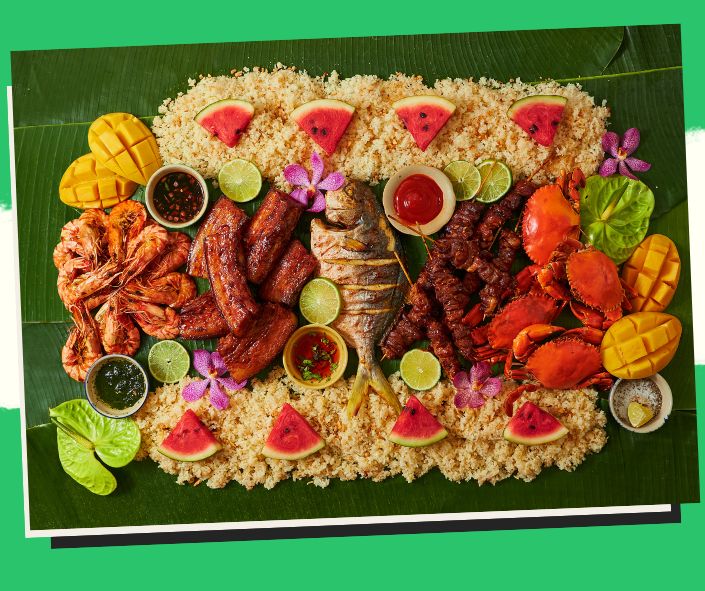
A Food Lover’s Guide to Philippine Dining and Cuisine
Explore the rich flavors of Filipino cuisine with our guide to the best dining experiences in the Philippines.
🍽️ A Culinary Journey: How to Enjoy Dining and Cuisine in the Philippines 🇵🇭
The Philippines, a tropical paradise with over 7,000 islands, offers a rich and diverse culinary scene. Filipino cuisine reflects the country’s vibrant culture and history, with influences from Malay, Chinese, Spanish, and American cuisines. Whether you’re a foodie eager to explore street food or a gourmet enthusiast looking for fine dining, this guide will help you navigate the culinary landscape of the Philippines. Discover essential information, useful tips, and delicious recommendations to make the most of your gastronomic adventure.
Understanding Filipino Cuisine 🥘
Filipino cuisine is a delightful mix of flavors and textures. Here are some key elements that define it:
Influences and History 🗺️
Filipino food is heavily influenced by various cultures due to centuries of trade and colonization. The Malay settlers introduced coconuts and rice, while Chinese traders brought noodles and soy sauce. The Spanish colonization introduced a variety of stews and desserts, and American influence added convenience foods like canned goods and fast food.
Flavor Profiles 🌶️
The flavors in Filipino cuisine are bold and diverse, often combining sweet, sour, salty, and umami in a single dish. Common ingredients include vinegar, soy sauce, fish sauce, garlic, onions, and tomatoes.
Cooking Methods 🍳
Filipino cooking methods range from simple to complex. Key techniques include:
- Adobo: A method of marinating meat in vinegar, soy sauce, garlic, and spices, then simmering until tender.
- Sinangag: A technique of frying leftover rice with garlic, often served for breakfast.
- Lechon: Roasting a whole pig over an open flame, commonly served during celebrations.
Must-Try Filipino Dishes 🍛
Adobo 🥩
Considered the unofficial national dish, adobo is a savory and tangy dish typically made with chicken or pork, marinated in vinegar, soy sauce, garlic, and spices, then simmered until tender.
Sinigang 🍲
A sour soup made with tamarind or other souring agents, sinigang is often cooked with pork, shrimp, or fish, and a variety of vegetables like kangkong (water spinach), radish, and eggplant.
Lechon 🐖
A highlight of Filipino celebrations, lechon is a whole roasted pig known for its crispy skin and tender meat. It’s often served with a liver-based sauce called lechon sauce or sarsa.
Pancit 🍜
A general term for noodles, pancit comes in many variations. Popular types include pancit canton (stir-fried noodles with meat and vegetables), pancit bihon (thin rice noodles), and pancit palabok (noodles with a rich shrimp sauce and various toppings).
Kare-Kare 🥘
A rich and hearty stew made with oxtail, tripe, and vegetables, cooked in a thick peanut sauce. It’s traditionally served with bagoong (fermented shrimp paste) on the side.
Halo-Halo 🍨
A refreshing dessert made with a mix of shaved ice, evaporated milk, sweetened fruits, jellies, and beans, topped with leche flan, purple yam, or ice cream.
Dining Etiquette in the Philippines 🏠
Filipino Hospitality 🤝
Filipinos are known for their hospitality, and this extends to their dining culture. When invited to a Filipino home, it’s customary to bring a small gift, such as pastries or fruits. Guests are often encouraged to eat more and will be offered food multiple times.
Table Manners 🍴
Filipinos typically eat with a spoon and fork, using the spoon to scoop food and the fork to push it onto the spoon. Eating with hands (kamayan) is also common, especially in rural areas or during informal meals. Always wait for the host to start eating before you begin.
Sharing Meals 🥂
Family-style dining is prevalent in the Philippines, where dishes are placed in the center of the table for everyone to share. Don’t be shy about trying everything and asking for seconds if you enjoyed a particular dish.
Exploring Street Food 🏙️
Street food is an integral part of Filipino culture, offering a chance to taste local flavors at affordable prices. Here are some must-try street foods:
Balut 🥚
A fertilized duck egg with a partially developed embryo, balut is a popular street food known for its unique taste and texture. It’s often eaten with a pinch of salt or vinegar.
Isaw 🍢
Grilled chicken or pork intestines, isaw is a beloved street snack. It’s marinated in a flavorful sauce before being grilled to perfection.
Fish Balls 🐟
Fish balls are skewered and deep-fried, then served with a variety of dipping sauces. They’re a favorite among kids and adults alike.
Banana Cue 🍌
Banana cue is a popular street dessert made by deep-frying saba bananas coated in caramelized sugar and skewered on sticks.
Taho 🍶
A sweet snack made of silken tofu, syrup, and tapioca pearls, taho is typically sold by street vendors in the morning. It’s a comforting and filling treat.
Discovering Regional Specialties 🌄
The Philippines’ diverse geography means each region has its own unique culinary specialties. Here are some notable ones:
Bicol Express 🌶️
From the Bicol region, this dish is made with pork cooked in coconut milk and spiced with plenty of chili peppers, reflecting the region’s love for spicy food.
La Paz Batchoy 🍲
A noodle soup originating from Iloilo, La Paz Batchoy is made with miki (egg noodles), pork organs, crushed pork cracklings, and a flavorful broth.
Ilocos Empanada 🥟
A deep-fried pastry filled with green papaya, mung beans, and either longganisa (local sausage) or an egg, Ilocos empanada is a popular snack in the Ilocos region.
Chicken Inasal 🍗
A famous dish from Bacolod, chicken inasal is marinated in a mixture of calamansi, vinegar, garlic, and annatto oil, then grilled to juicy perfection.
Kinilaw 🐟
The Filipino version of ceviche, kinilaw is made with raw fish marinated in vinegar, calamansi juice, onions, and various spices. It’s a refreshing dish perfect for hot days.
Tips for Eating Out in the Philippines 🍴
Restaurant Types 🏢
The Philippines offers a variety of dining options, from street food stalls and carinderias (local eateries) to fast food chains and fine dining restaurants. Carinderias are great for trying home-cooked Filipino meals at budget-friendly prices, while fine dining restaurants offer a more upscale experience.
Reservation Tips 📅
In popular tourist areas and high-end restaurants, it’s advisable to make reservations, especially during peak dining hours and weekends. For casual dining spots, reservations are usually not necessary.
Dietary Considerations 🥗
Filipino cuisine can be quite meat-heavy, but there are options for vegetarians and vegans. Look for dishes like pinakbet (vegetable stew), ginataang gulay (vegetables in coconut milk), and various tofu dishes. For those with dietary restrictions, it’s helpful to communicate your needs to the restaurant staff, who are generally accommodating.
Cooking Classes and Food Tours 👩🍳
Learning to Cook Filipino Dishes 🍳
Taking a cooking class is a great way to immerse yourself in Filipino cuisine. Many cooking schools and local chefs offer classes where you can learn to make traditional dishes like adobo, lumpia, and halo-halo. These classes often include a market tour to source fresh ingredients, adding to the cultural experience.
Food Tours 🚌
Food tours are an excellent way to explore the culinary landscape of the Philippines. Guided by local experts, you’ll visit various eateries, markets, and street food stalls, tasting a wide range of dishes. Food tours can be found in major cities like Manila, Cebu, and Davao.
Supporting Sustainable and Local Food Practices 🌿
Farm-to-Table Restaurants 🥗
The farm-to-table movement is growing in the Philippines, with many restaurants focusing on locally sourced, sustainable ingredients. These establishments often highlight seasonal produce and support local farmers. Examples include Antonio’s in Tagaytay and Farmer’s Table in Nasugbu.
Organic Markets 🛒
Visiting organic markets is a great way to support sustainable agriculture and enjoy fresh, organic produce. Salcedo Saturday Market and Legazpi Sunday Market in Makati are popular spots for organic and artisanal goods.
Responsible Seafood Consumption 🐟
Given the Philippines’ rich marine biodiversity, it’s important to support sustainable seafood practices. Look for restaurants and markets that source seafood responsibly, ensuring the protection of marine ecosystems.
Final Thoughts and Recommendations 🌟
Must-Visit Dining Destinations 🌏
- Manila: A bustling metropolis with a mix of traditional and modern dining experiences. Don’t miss the vibrant food scene in Binondo, the world’s oldest Chinatown.
- Cebu: Known for its lechon and seafood, Cebu offers a range of dining options from street food to fine dining.
- Davao: Famous for its durian and fresh fruits, Davao also boasts a variety of seafood dishes and local delicacies.
- Boracay: Beyond its beautiful beaches, Boracay has a thriving food scene with beachfront restaurants and bars offering fresh seafood and international cuisine.
Packing Essentials for Foodies 🧳
- Reusable utensils and containers
- A travel-sized bottle of hand sanitizer
- A small notebook for jotting down food discoveries
- A reusable water bottle
- An appetite for adventure and an open mind
Benefits of Dining and Cuisine in the Philippines 🍲🌟
1. Rich Culinary Heritage 🏺🍛
The Philippines offers a unique blend of flavors influenced by its diverse cultural history. Each region has its own specialties, providing a rich tapestry of tastes to explore.
2. Fresh and Locally Sourced Ingredients 🥦🐟
With abundant natural resources, Filipino cuisine often features fresh seafood, tropical fruits, and locally grown vegetables, ensuring high-quality meals.
3. Variety of Flavors 🌶️🍯
Filipino dishes are known for their bold flavors, often combining sweet, sour, salty, and spicy elements to create a dynamic culinary experience.
4. Street Food Culture 🏙️🌮
Street food is an integral part of Filipino culture, offering delicious and affordable options that allow you to experience local flavors authentically.
5. World-Class Chefs and Restaurants 👨🍳🍷
The Philippines is home to numerous world-class chefs and acclaimed restaurants that elevate traditional Filipino cuisine with modern twists.
6. Warm Filipino Hospitality 🤗🍴
Dining in the Philippines is often accompanied by warm hospitality, making meals a delightful and memorable experience.
7. Diverse Dining Settings 🌅🍽️
From beachside eateries to mountain-top restaurants, the Philippines offers diverse dining settings that enhance the culinary experience.
8. Unique Culinary Festivals 🎉🍜
The Philippines hosts numerous food festivals celebrating local delicacies, offering a great way to immerse yourself in Filipino culinary traditions.
9. Fusion Cuisine 🍣🍕
Filipino cuisine embraces fusion, blending traditional recipes with modern techniques and international flavors to create innovative dishes.
10. Affordable Dining 💵🍲
Whether dining in a local eatery or a high-end restaurant, you can enjoy delicious meals at affordable prices compared to many Western countries.
Case Studies: Culinary Experiences 🌏
1. Anthony Bourdain’s Love for Filipino Food
Background: Renowned chef and TV host Anthony Bourdain visited the Philippines and praised its cuisine.
Experience: Bourdain highlighted dishes like sisig and lechon as world-class, bringing international attention to Filipino food.
Benefit Highlighted: Rich culinary heritage and bold flavors.
2. Hidden Beachside Gem in Palawan: KaLui Restaurant
Background: A travel blogger from Canada discovered KaLui Restaurant in Palawan.
Experience: She was impressed by the fresh seafood and artistic presentation of dishes in a cozy beachside setting.
Benefit Highlighted: Fresh ingredients and diverse dining settings.
3. Street Food Adventure in Manila
Background: A group of friends from Japan explored Manila’s street food scene.
Experience: They enjoyed delicacies like balut, kwek-kwek, and isaw, experiencing local culture firsthand.
Benefit Highlighted: Street food culture and affordability.
4. Fine Dining at Antonio’s in Tagaytay
Background: A business executive from Singapore dined at Antonio’s during a trip to Tagaytay.
Experience: He was impressed by the fusion cuisine and elegant atmosphere, deeming it one of the best dining experiences.
Benefit Highlighted: World-class chefs and fusion cuisine.
5. Culinary Festival in Pampanga
Background: A family from Australia attended the Giant Lantern Festival in Pampanga.
Experience: They enjoyed traditional Kapampangan dishes like sisig and bringhe while participating in festive activities.
Benefit Highlighted: Unique culinary festivals and rich heritage.
6. Vegan Delight at Green Bar in Makati
Background: A vegan traveler from Germany found Green Bar in Makati.
Experience: She was delighted by the creative vegan options, proving that Filipino cuisine can cater to diverse dietary needs.
Benefit Highlighted: Diverse flavors and world-class restaurants.
7. Beachfront Dining at Pearl Farm Beach Resort, Davao
Background: A honeymoon couple from the UK dined at Pearl Farm Beach Resort.
Experience: They enjoyed a romantic dinner with fresh seafood and spectacular ocean views.
Benefit Highlighted: Fresh ingredients and diverse dining settings.
8. Traditional Fiesta in Iloilo
Background: A cultural enthusiast from Italy attended a local fiesta in Iloilo.
Experience: She was immersed in the vibrant atmosphere, enjoying traditional dishes like La Paz Batchoy and Pancit Molo.
Benefit Highlighted: Unique culinary festivals and warm hospitality.
9. Innovative Cuisine at Gallery by Chele
Background: A food critic from the USA visited Gallery by Chele in Manila.
Experience: She was fascinated by the innovative dishes that combined traditional Filipino ingredients with modern culinary techniques.
Benefit Highlighted: Fusion cuisine and world-class chefs.
10. Affordable Dining at Gerry’s Grill
Background: A budget traveler from India dined at Gerry’s Grill across various locations.
Experience: He enjoyed hearty Filipino meals at reasonable prices, appreciating the value for money.
Benefit Highlighted: Affordable dining and rich flavors.
Key Takeaways 📋
1. Rich Culinary Heritage: The Philippines boasts a diverse culinary tradition influenced by various cultures.
2. Fresh Ingredients: Meals often feature fresh, locally sourced seafood, fruits, and vegetables.
3. Bold Flavors: Filipino cuisine is known for its dynamic and bold flavor combinations.
4. Street Food: Street food culture offers an authentic and affordable way to experience local flavors.
5. Top Chefs: The country is home to world-class chefs who innovate and elevate Filipino cuisine.
6. Warm Hospitality: Dining experiences are enhanced by the warm and welcoming nature of Filipino hospitality.
7. Diverse Settings: From beachside to mountaintop, the Philippines offers unique dining environments.
8. Culinary Festivals: Food festivals provide an immersive way to explore Filipino culinary traditions.
9. Fusion Cuisine: Traditional recipes are often blended with modern techniques and international flavors.
10. Affordability: Dining in the Philippines offers great value, making it accessible to a wide range of budgets.
FAQs About Dining and Cuisine in the Philippines ❓
1. What are some must-try Filipino dishes?
Adobo, sinigang, lechon, sisig, and pancit are some iconic Filipino dishes that you should try.
2. Is Filipino cuisine spicy?
Filipino cuisine is generally not very spicy, but dishes like Bicol Express and kinilaw can be quite hot.
3. What is the best time to visit for culinary festivals?
December and January are great times to visit for festivals, including the Giant Lantern Festival in Pampanga and Sinulog in Cebu.
4. Are there vegan and vegetarian options available?
Yes, while traditional Filipino cuisine is meat-heavy, many restaurants offer vegan and vegetarian options.
5. What is a typical Filipino breakfast?
A typical Filipino breakfast includes dishes like tapa (cured beef), tocino (sweet cured pork), longganisa (Filipino sausage), and fried rice, often served with a fried egg.
6. Can I find international cuisine in the Philippines?
Yes, major cities like Manila, Cebu, and Davao have a wide range of international restaurants offering diverse global cuisines.
7. Is it safe to eat street food?
Generally, yes, but it’s advisable to choose vendors that are popular and have a high turnover to ensure freshness and hygiene.
8. What are some popular Filipino desserts?
Halo-halo, leche flan, bibingka, and ube halaya are popular Filipino desserts that are a must-try.
9. How much does a typical meal cost in the Philippines?
Prices vary, but street food can cost as little as $1-2 per dish, while dining in mid-range restaurants might cost around $5-15 per meal.
10. Are there any dietary restrictions to be aware of?
Filipino cuisine often includes pork, but many restaurants can accommodate dietary restrictions. It’s best to inform the staff of any specific needs.
Conclusion
Embarking on a culinary journey through the Philippines promises a feast for the senses. With its diverse flavors, regional specialties, and warm hospitality, every meal becomes an unforgettable experience.
From bustling city streets to quaint provincial towns, the Philippines offers a culinary adventure like no other. Whether you’re savoring the tangy flavors of sinigang in a local eatery, indulging in the crispy goodness of lechon at a fiesta, or exploring the vibrant street food scene in Manila, every bite tells a story of tradition, culture, and passion.
So pack your appetite and embark on a gastronomic adventure through the flavors of the Philippines. From the bustling markets of Manila to the pristine beaches of Palawan, there’s always something new to discover and savor in this culinary paradise. With each dish, you’ll not only satisfy your hunger but also nourish your soul with the rich tapestry of flavors and experiences that make Filipino cuisine truly special.
Bon appétit and enjoy your culinary journey through the Philippines! 🍽️🇵🇭
Key Phrases
- “Best restaurants in the Philippines”
- “Authentic Filipino cuisine”
- “Top dining spots Philippines”
- “Where to eat in the Philippines”
- “Philippine food guide”
- “Must-try Filipino dishes”
- “Philippines culinary experiences”
- “Top Filipino restaurants”
- “Best places to dine Philippines”
- “Philippines foodie destinations”
Best Hashtags
- #PhilippinesCuisine
- #FilipinoFood
- #DiningInPhilippines
- #PhilippinesEats
- #FoodiePhilippines
- #TastePhilippines
- #PhilippineRestaurants
- #ExplorePhilippineFood
- #BestOfPhilippines
- #CulinaryPhilippines
DisclaimerThe information is for educational purposes only and subject to change, and it is highly recommended to consult local authorities for the latest and most accurate updates. We do not constitute endorsement of any specific technologies or methodologies or endorse of any specific products or services.📩 Need to get in touch?Feel free to Email Us for comments, suggestions, reviews, or anything else. |











Comments (0)